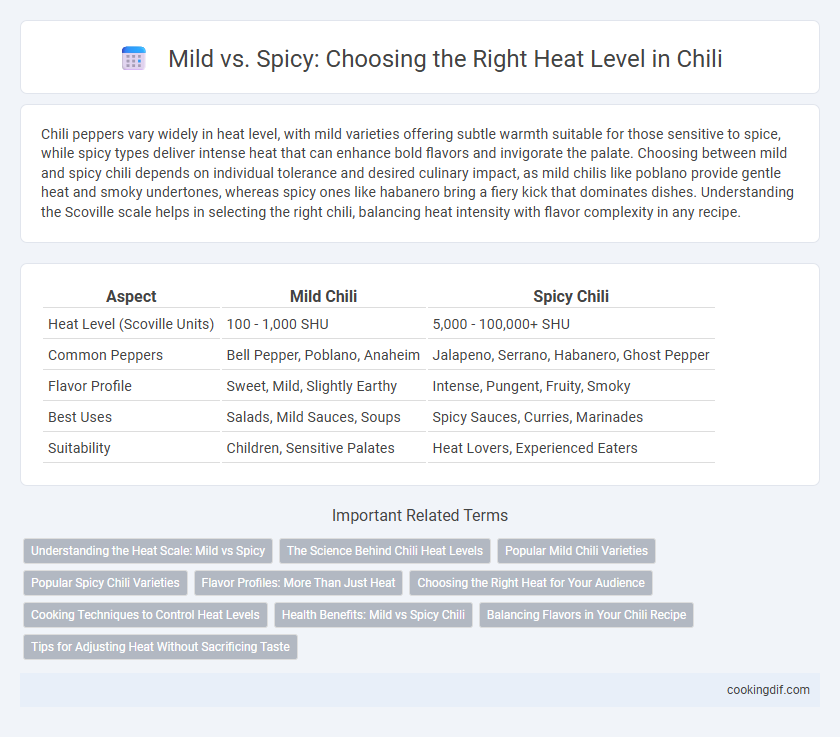Chili peppers vary widely in heat level, with mild varieties offering subtle warmth suitable for those sensitive to spice, while spicy types deliver intense heat that can enhance bold flavors and invigorate the palate. Choosing between mild and spicy chili depends on individual tolerance and desired culinary impact, as mild chilis like poblano provide gentle heat and smoky undertones, whereas spicy ones like habanero bring a fiery kick that dominates dishes. Understanding the Scoville scale helps in selecting the right chili, balancing heat intensity with flavor complexity in any recipe.
Table of Comparison
| Aspect | Mild Chili | Spicy Chili |
|---|---|---|
| Heat Level (Scoville Units) | 100 - 1,000 SHU | 5,000 - 100,000+ SHU |
| Common Peppers | Bell Pepper, Poblano, Anaheim | Jalapeno, Serrano, Habanero, Ghost Pepper |
| Flavor Profile | Sweet, Mild, Slightly Earthy | Intense, Pungent, Fruity, Smoky |
| Best Uses | Salads, Mild Sauces, Soups | Spicy Sauces, Curries, Marinades |
| Suitability | Children, Sensitive Palates | Heat Lovers, Experienced Eaters |
Understanding the Heat Scale: Mild vs Spicy
Understanding the heat scale in chili involves recognizing that mild varieties typically measure between 100 to 1,000 Scoville Heat Units (SHU), offering subtle warmth without overwhelming intensity. Spicy chilies, on the other hand, range from 30,000 to over 100,000 SHU, delivering significant heat that can enhance the flavor complexity of dishes. Selecting the appropriate heat level depends on personal tolerance, culinary application, and the desired balance between flavor and spiciness.
The Science Behind Chili Heat Levels
Chili heat levels are determined by the concentration of capsaicin, a chemical compound that binds to pain receptors in the mouth, triggering a sensation of heat. Scoville Heat Units (SHU) measure this intensity, with mild chilies like Poblano scoring between 1,000 to 1,500 SHU, while spicy varieties such as Habanero can exceed 300,000 SHU. The human body's response to capsaicin involves releasing endorphins, which can create a pleasurable burning sensation despite the perceived heat.
Popular Mild Chili Varieties
Popular mild chili varieties like Anaheim, Poblano, and Cherry Peppers offer a gentle heat level ranging from 100 to 1,000 Scoville Heat Units (SHU), making them ideal for those sensitive to spiciness. These mild chili peppers provide rich, smoky, and slightly sweet flavors that enhance dishes without overwhelming heat. Incorporating mild chilies into recipes allows for flavorful meals that accommodate diverse palates while maintaining a lower heat intensity.
Popular Spicy Chili Varieties
Popular spicy chili varieties like Habanero, Ghost Pepper, and Carolina Reaper deliver intense heat levels ranging from 100,000 to over 2 million Scoville Heat Units (SHU). Mild chili options such as Jalapeno and Anaheim peppers provide moderate heat, typically between 2,500 and 5,000 SHU, making them ideal for those preferring less spice. Understanding the heat scale helps chili enthusiasts choose the right pepper to match their desired flavor intensity and culinary use.
Flavor Profiles: More Than Just Heat
Mild chili varieties, such as Anaheim or Poblano peppers, offer a balanced flavor profile with subtle sweetness and earthy undertones, enhancing dishes without overwhelming heat. Spicy chilies, like habanero or ghost peppers, deliver intense heat alongside complex fruity or smoky notes that elevate the depth and richness of recipes. Understanding the nuanced flavor profiles of mild versus spicy chilies allows chefs and home cooks to select peppers that complement ingredients while tailoring heat levels to personal preference.
Choosing the Right Heat for Your Audience
Choosing the right heat level for chili is essential to satisfy diverse taste preferences and avoid overwhelming your guests. Mild chili appeals to those sensitive to spice or children, featuring subtle heat from ingredients like paprika or mild chili powders. Spicy chili incorporates hotter peppers such as jalapenos or habaneros to deliver bold, intense heat that excites enthusiasts seeking a fiery experience.
Cooking Techniques to Control Heat Levels
Cooking techniques such as toasting, roasting, or soaking chili peppers can effectively control the heat level by altering capsaicin concentration, the compound responsible for spiciness. Removing seeds and membranes from mild chili varieties significantly reduces heat, while slow simmering blends flavors and mellows the spiciness in spicy chilies. Marinating or pairing with dairy ingredients further balances heat intensity, creating a controlled and enjoyable flavor profile.
Health Benefits: Mild vs Spicy Chili
Mild chili varieties contain lower capsaicin levels, making them gentler on the digestive system and suitable for individuals with sensitive stomachs. Spicy chili peppers, rich in capsaicin, promote metabolism, reduce inflammation, and may aid in pain relief by stimulating endorphin production. Consuming spicy chili in moderation supports cardiovascular health and enhances immune function through its antioxidant properties.
Balancing Flavors in Your Chili Recipe
Balancing flavors in your chili recipe involves carefully adjusting the heat level to complement rather than overpower other ingredients. Mild chili allows the rich aroma of spices like cumin and paprika to shine, enhancing the overall depth without overwhelming heat. Spicy chili, infused with ingredients like jalapenos or cayenne, brings a vibrant kick that intensifies the savory notes while engaging the palate with bold, layered flavors.
Tips for Adjusting Heat Without Sacrificing Taste
Adjust heat levels in chili by using milder peppers like poblano or Anaheim to reduce spiciness without compromising flavor complexity. Incorporate dairy elements such as sour cream or cheese to mellow heat while enhancing creaminess and balance. Toast spices separately before mixing to deepen flavor intensity, allowing a satisfying taste experience regardless of heat preference.
Mild vs Spicy for heat level Infographic

 cookingdif.com
cookingdif.com